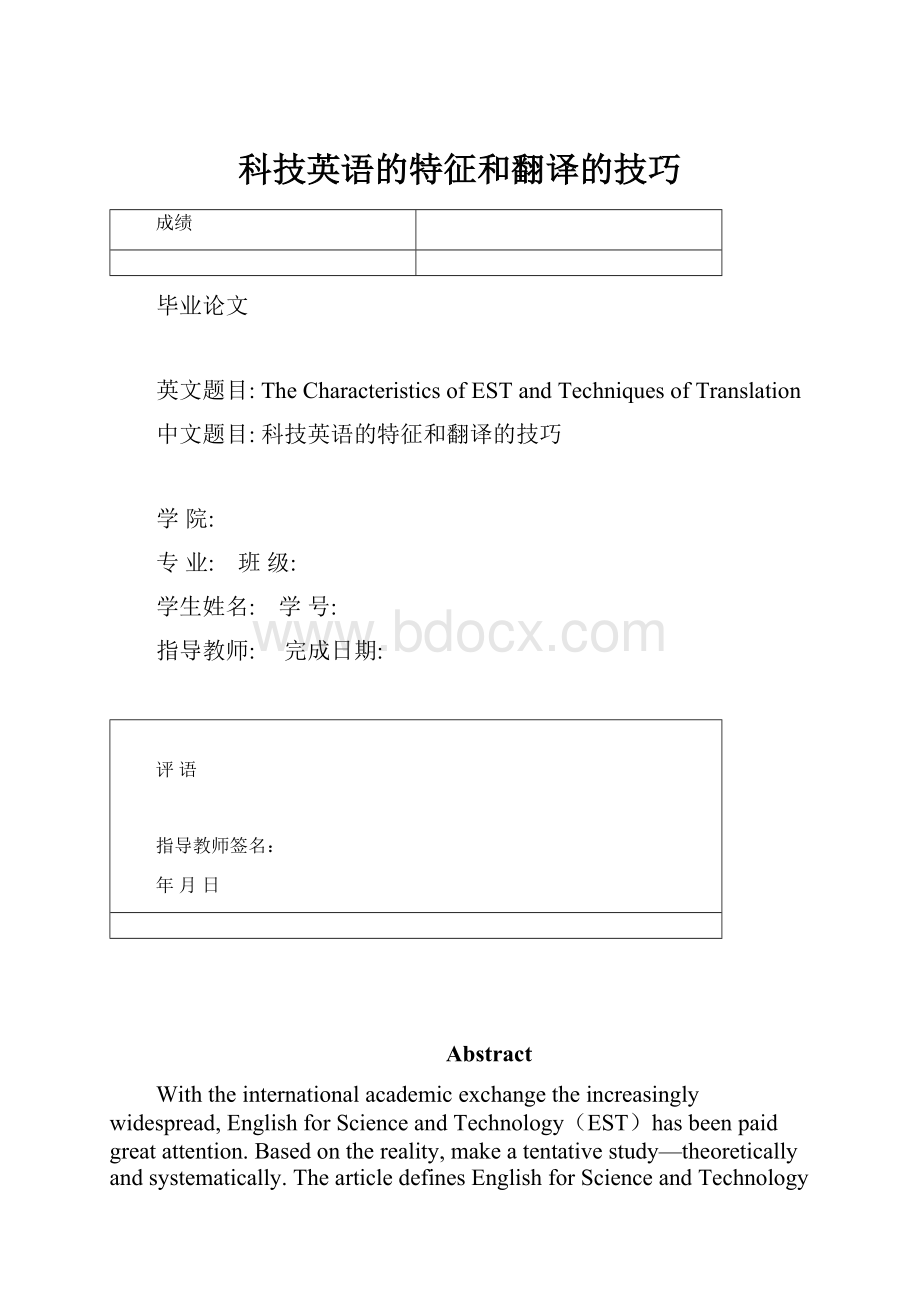科技英语的特征和翻译的技巧.docx
《科技英语的特征和翻译的技巧.docx》由会员分享,可在线阅读,更多相关《科技英语的特征和翻译的技巧.docx(21页珍藏版)》请在冰豆网上搜索。

科技英语的特征和翻译的技巧
成绩
毕业论文
英文题目:
TheCharacteristicsofESTandTechniquesofTranslation
中文题目:
科技英语的特征和翻译的技巧
学院:
专业:
班级:
学生姓名:
学号:
指导教师:
完成日期:
评语
指导教师签名:
年月日
Abstract
Withtheinternationalacademicexchangetheincreasinglywidespread,EnglishforScienceandTechnology(EST)hasbeenpaidgreatattention.Basedonthereality,makeatentativestudy—theoreticallyandsystematically.ThearticledefinesEnglishforScienceandTechnologyfromthedevelopmenthistoryofEnglishtranslation.Whatthekindofthestyletypeisit.Comparedwithotherstyletypes,whatisthedifficulty?
Thenextstep,theauthordetaileddemonstratesthecharacteristicsofESTfromtwosides:
vocabularyandsyntax.Andtheauthorcomesupwiththeprinciplesoftranslation.FinallystatethetechniquesofEST’stranslationsystematicallyinorderthatitcanhelppeoplegraspthebasicrulesandcommonlyusedskillsofEST’Stranslationandpracticaltranslatingtechniques.SotheycanmakegreatprogressintranslatingEnglishforScienceandTechnology.Thepurposeofmypaperismainlytohelppeopleread,understandandenjoythesciencearoundthemineverydaylife.
Keywords:
EST,languagecharacteristics,translation,principles,techniques
摘要
随着国际学术交流的日益广泛,科技英语已经受到普遍的重视,针对现状对科技英语翻译方法与技巧作了综合、系统性理论研究。
本文从英语翻译发展的历史讲起,论述了科技英语的定义,它是种什么样的文体类型,与其他类型文体相比有什么不同之处。
接着通过详细的从词汇,句法两个方面来介绍它的语言特点,并提出了翻译的原则。
最后引出我们翻译科技英语的一些技巧。
目的是在于帮助人们运用所学的知识,掌握科技英语翻译的基本规律和方法,以及非常实用的翻译技巧,提高他们科技英语的翻译能力,便于他们了解周围的科技成果.
关键词:
科技英语,语言特点,翻译,原则,技巧
Contents
AbstractI
摘要II
ContentsIII
Chapter1Introduction1
1.1Context1
1.2SignificanceoftheStudy1
1.3ShapeofthePaper2
Chapter2TheCharacteristicsofEST3
2.1DefinitionofEST4
2.2CharacteristicsInVocabularyofEST4
2.21Affixation5
2.22Compounding5
2.23Blending6
2.24Acronym6
2.25ProperNouns7
2.3CharacteristicsInSyntaxofEST7
2.31MoreLongandComplicatedSentences7
2.32MoreNominalization8
2.33ExtensiveUseofThePassiveVoice8
2.34MoreNon-FiniteFormsoftheVerb9
2.35DifferentUsesoftheTense9
2.36ThePost-positionoftheAttributive9
Chapter3TechniquesEmployedintheTranslationofEST10
3.1Faith-fullnessExpressivenessandElegance10
3.2SemanticExtension11
3.21SemanticConversion11
3.22SemanticMaterialization12
3.23SemanticAbstraction12
3.3SemanticAmplificationorOmission12
3.4WordConversion13
3.41ConvertingintoVerbs13
3.42ConvertingintoNouns13
3.43ConvertingintoAdjectives14
3.44ConvertingintoAdverbs14
3.5LongSentences15
3.51MethodsofTranslatingLongSentencesinEST15
Chapter4Conclusion19
Bibliography20
Chapter1Introduction
1.1Context
Withthedevelopmentofscienceandtechnologyandthegradualpenetrationofglobaleconomicintegration,EnglishforScienceandTechnology(EST)attractedmoreandmoreattentionandconcernofexpertsinlanguageandsciencecommunity.ESTisincreasinglyshowingitsuniqueness.Ithasbecomeanindependentstyle.Translationisaprocesstouseanotherlanguagetoexpressexpressedthingsinonelanguagefluentlyandaccurately.Comparedwithothersubjects’essay,scientificspecializedcontextsdogreatlydifferinthecontent,theformofexpressionandstyle.Ithasthecharacteristicsofstrongtechnology,strongspecialtyandstrong,tightlogicandsuccinctexpression.
1.2SignificanceoftheStudy
ThispaperdiscussedthetranslationandtechniquesofEnglishforScienceandTechnology.Basedonthereality,thepresentthesisaimsatmakingatentativestudy—theoreticallyandsystematically.Inourdailylife,weoftenreadvariouskindsofarticleswritteninEnglish.TheauthordemonstratesthecharactersofEnglishforScienceandTechnologyandexplainsthetechniquesthattheteachersinteachingtranslationofculturalEnglishandEnglishforScienceandTechnology.TheauthoralsostatesthecriteriaandtechniquesofEST’stranslationsystematicallyinorderthatitcanhelpstudentsgraspthebasicrulesandcommonlyusedtechniquesofEST’stranslationandpracticaltranslatingtechniques.SotheycanmakegreatprogressintranslatingEnglishforScienceandTechnology.Thepurposeofmypaperismainlytohelpyoungpeopleread,understandandenjoythesciencearoundthemineverydaylife.
1.3ShapeofthePaper
Thisthesisincludesfourparts.
Chapter1,theintroductionpart,whichwillbeinitiatedbyintroducingthecontext,researchproblemsandsignificanceofthestudy.
Chapter2touchesbrieflyupontheknowledgeofEST--itstwocharacters.EnglishandChinesearesodifferentthattheyformtheirowncharacters.AndEnglishforScienceandTechnologyhasitscharacteristics.Authorstatesitstwocharactersinvocabularyandsyntax.
Chapter3statesbasicprinciplesemployedinthetranslationofEST.Faith-fulnessl,expressivenessandelegancearethethreeprinciplesinthetranslationofEST.AnditpresentseveraltechniquesemployedinthetranslationofEST.
TheconclusionchaptergeneralizescharacteristicsofESTandprinciples,techniquesoftranslation.Atlaststatemypurpose.
Chapter2TheCharacteristicsofEST
InChina,translationfirstexistedasthepurposeofforeignlanguagelearningandwastaughtasacourseasearlyasintheMingDynasty.IntheQingDynasty,Englishwasfirsttaughtin同文馆whosepurposewasalsototrainprofessionaltranslatorsforthegovernment.Generallyspeakingfrom1920sto1949,themainmethodusedinEnglishteachinginordinaryschoolswasthemethodofgrammar-translationFromtheyear1949to1956,onlyBasicEnglishwastaughtintheuniversitiesbecausemanystudentsstudiedRussianinthemiddleschools.Since1977,Englishhasregaineditspopularity,andEnglishinstructiontodayisbetterthanitwaseverbefore.WiththeexchangebetweenChinaandtheEnglishspeakingcountriesinEnglishteaching,includingtheexchangeofresearchandteachingstaff,theexchangeoftextbooksandacademicperiodicals.peoplebegantohaveabetterunderstandingofthetheoryandpracticeofEnglishteachinginforeigncountries,whichhasgreatinfluenceonthedevelopmentofEnglishteachinginChina.Translation,ononehand,isusedasamethodinEnglishteaching,ontheotherhand,isregardedasaseparatecoursefortheEnglishmajorsintheforeignlanguagecollegesanddepartments.Meanwhiletranslationisalsotreatedasoneofthefivebasicskillsforthenon-Englishmajorstudentsinalmosteveryuniversity.
EnglishandChinesearedifferentkindsoflanguages.Becauseofthedifferencesinregionandculturebackground,theusesofthesetwolanguagesarecompletelydifferent.Theyformedtheirownuniquestylesandcharacters.TheteachingofESTtranslationandtechniquescanhelppeoplelearnEnglishwellandincreasetheirabilityoftranslation.
2.1DefinitionofEST
ESTisthelanguageusedintheprofessionalcontextsofnaturalscienceandtechnology.Itisdifferentfromotherstyletypes.
1.ESTdoesnothavetheemotionalcolor.Itspurposeistomakethereaderunderstandeasilyanddonotproducetoomuchimagination.Alsodonotoftenuseparables,parallelism,hyperbolerhetoric,buttoaccuratelyexpresstheobjectivelaw,accordingtologicalthinkingclearlydescribetheproblem.
2.ThevocabularyofESTmeaningissingle-minded,stable,especiallyalargenumberofprofessionaltermswhichmeaningisfixed,exclusive.Eveniflike“do,take,make”thesecommonverbswhichhavemanymeanings.Theyalsocomparativelyfixedthemeaningofwords.TheexpressioniseasytounderstandinEST.
3.ESTisawrittenlanguage.Itrequiresrigorous,concise,anddoesn'taskforthemagnificentwordsaccumulation.Italsodoesnotconsiderreadingandreciting.
Generallyspeaking,thereisnospecialrequirementforthetranslationofESTincomparisonwithgeneralEnglishexceptforitswordingandcharacteristicstructures.HereIamgoingtosurveythetranslationofESTintwoaspects:
Itsvocabularyandsyntax(刘宓庆,1998).
2.2CharacteristicsInVocabularyofEST
OneofthemostdistinctivefeatureofESTisitstechnicalterms,whichnotonlyaccountforalargepartofEnglishvocabulary,butalsoarethemostimportantsourceofnewlycoinedwordsinmodernEnglish,rangingoveranextensiveareaofvariousfields(马万超,2006).AmasteryofthemwillbenefitusagreatdealintranslationofEST.
Intermsofform,Englishtechnicaltermsmaybeclassifiedintothreecategories,namely,singlewords(e.g.Internet因特网.)compoundforms(e.g.splashdown溅落.)andphrases(e.g.on-and-off-the-road路面越野两用的).Sincemostofthetechnicaltermscomeoutofthebasicrulesofword-formation.It’snecessaryforustoconductabriefsurveyoftheirformation------affixation,compounding,blending,acronym,propernouns(潘尔艳,2006).
2.21Affixation
Affixationisanimportantmeansofcoiningnewwordsandtechnicalterms,withprefixandsuffixasinseparableelementsofthewordsbeingcoined.Theseprefixesandsuffixesarefamiliartous.Manytechnicaltermsofsuchformationcanbetranslatedappropriately.Theadvantageofaffixationisevident:
itisthemostflexiblemeansofformingnewwordsanditspotentialofcreationisalmostboundless,thereforeitisextensivelyusedintheformationoftechnicalterms.BesidesprefixandsuffixofEnglishorigin,therearesomeforeignborrowings,noticeablytheLatinones,e.g.bio-(生命、生物),thermo-(热),electro-(电),aero-(空气),carbo-(碳),hydro-(水),-mania(热、狂),etc.Ifwearefamiliarwiththeseprefixesandsuffixes,manytechnicaltermsofsuchformationcanbetranslatedappropriately.Thefollowingaresometypicalexamples.
Bathythermograph=bathy+thermo+graph海水测量仪
Deoxyribonucleic=de+oxy+ribo+nucleic脱